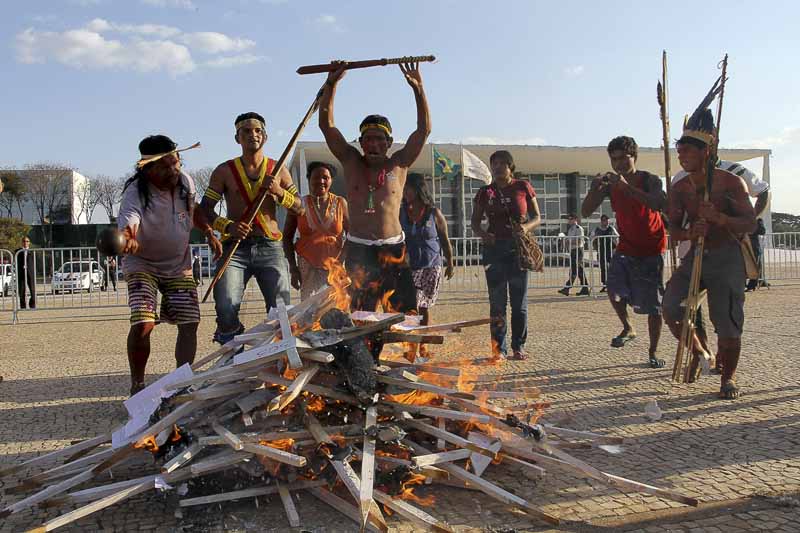
by Deep Green Resistance News Service | Oct 9, 2012 | Biodiversity & Habitat Destruction, Colonialism & Conquest, Indigenous Autonomy, Obstruction & Occupation
By Jeremy Hance / Mongabay
Construction on Brazil’s megadam, Belo Monte, has been halted again as around 150 demonstrators, most of them from nearby indigenous tribes, have occupied the main construction site at Pimental. Over a hundred indigenous people joined local fishermen who had been protesting the dam for 24 days straight. Indigenous people and local fishermen say the dam will devastate the Xingu River, upending their way of life.
“The renewed occupation of the project’s earthen cofferdams paralyzed construction works, while indigenous protestors seized the keys of trucks and tractors forcing workers to leave the strategic Pimental work camp on foot,” reads a press release from the NGO Amazon Watch. Around 900 workers were sent home.
This is the second occupation attempt in less than six months. Over the summer some 300 indigenous people sustained an occupation of the dam for 21 days, before breaking it off though little headway was made in talks with consortium building the dam, Norte Energia.
The Belo Monte dam, which would be the world’s third largest, has been plagued by controversy from its origin decades ago; the battle for the dam has been fought both in Brazil’s courts and on the international stage. If built, the dam will flood an estimated 40,000 hectares of present rainforest and could push some fish species to extinction. In addition, 16,000 people will be displaced according to the government, though some NGOs say the number is more likely double that.
Despite the impacts, the dam has been strongly supported by Brazilian President Dilma Rousseff, and every legal injunction against the dam has been overturned. Norte Energia has filed with a local court for repossession of the construction sties.
Indigenous groups say the construction of the dam is already imperiling their way of life, as the Xingu river becomes more difficult to navigate. They have also said they have no intention of leaving until Norte Energia meets their demands.
“We are witnessing the devastation of this land. The island of Pimental was completely destroyed, with a sole tree left standing, and the water is putrid. It is very shocking,” an protestor told Amazon Watch.
Dams are often described as ‘green’ energy source, however in the tropics they actually release significant methane emissions due to rotting vegetation. Although it has a shorter life than carbon, methane is a far more potent greenhouse gas.
From Mongabay: “Indigenous groups re-occupy Belo Monte dam in the Amazon“
by Deep Green Resistance News Service | Oct 9, 2012 | Climate Change
By Phys.org
Richard York, a researcher with the Department of Sociology and Environmental Studies Program at the University of Oregon, has found that a measured reduction in CO2 emissions during economic downturns is not on par with the increase in CO2 emissions that is apparent during boon times.
York made this discovery after analyzing the Gross Domestic Product (GDP) of several nations during the period 1960 to 2008, and then comparing these values with the countries’ corresponding annual measures of CO2 emissions. The results are published in the journal Nature Climate Change.
Conventional thinking held that greenhouse gas emissions will tumble at the same rate as they rise depending on economic conditions. York wasn’t convinced: accordingly, he decided to study the ups and downs of the economies of 150 of the world’s major countries over the course of nearly a half century.
He then compared each country’s GDP and carbon emission measures over time. What he found was that, on average, CO2 emissions rose by 0.73 percent for every 1 percent rise in GDP during economically prosperous times, but fell just 0.43 percent for every 1 percent fall in GDP during economically depressed periods , indicating that greenhouse gasses fall at roughly half the rate that they rise.
York has a theory regarding this observed phenomenon— CO2 emission levels are partly based on a country’s economic and infrastructure history. If a country builds factories, cars and roads during strong economic times, this infrastructure and machinery will still be there when the economy experiences a dip. And, while the new assets may be used less during difficult times, there is very little chance they won’t be used at all. Therefore, carbon emissions, while somewhat decreased, will never return to their pre-development levels.
York’s findings are likely to dampen one of the few bright spots surrounding the economic malaise currently impacting many countries, particularly Europe. The hope—that slow economic growth was decreasing the amount of CO2 being added to the atmosphere, thereby minimizing global warming, and as some have suggested, weather volatility—may be little more than wishful thinking. York concludes by suggesting that, based on his results, governments worldwide will likely need to rethink their predictions regarding CO2 emissions.
This might be particularly true for those countries that set their goals based on assumptions made at the 2009 Copenhagen summit, which focused on nations working together to combat the problems of greenhouse gas emissions and global warming, and which was organized around conventional theories of CO2 emissions in developed and developing nations.
From Phys.org: http://phys.org/news/2012-10-environmentalist-co2-faster-good-falls.html#jCp

by Deep Green Resistance News Service | Oct 6, 2012 | Colonialism & Conquest, Indigenous Autonomy, Mining & Drilling, Obstruction & Occupation
By Survival International
A protest involving Earth’s most threatened tribe, the Awá, has forced the world’s largest iron ore mine to suspend operations along its main railway line.
On Tuesday, hundreds of Indians including the Awá, took to the tracks of Vale’s Carajás railway to voice their opposition to Brazilian government plans that could weaken their land rights, if legalized.
The demonstration follows months of anger surrounding a draft text called Directive 303, which prohibits the expansion of indigenous territories.
The government has refused to scrap the proposed directive, despite it violating national and international laws by suggesting certain projects can be carried out on Indian land without proper consultation.
Frustrations spilled over on Tuesday, with several different tribes uniting to demand that their land rights are respected.
The blockade is the latest in a string of controversies to involve mining giant Vale, whose railway borders the territory of the Awá.
Last month, a judge reversed a ruling that had stopped the company from doubling its railway line to increase production.
The decision was a blow for the Awá, who blame the railway for bringing thousands of invaders into their lands and scaring off the animals they hunt.
Survival’s Director Stephen Corry said today, ‘If Brazil wants to lead the way and show the world that it respects its indigenous peoples, it should not be entertaining the harmful propositions of a handful of rural lobbyists. This protest shows that for tribes like the Awá, land rights are make or break.’
From Survival International: http://www.survivalinternational.org/news/8722
by Deep Green Resistance News Service | Oct 5, 2012 | Colonialism & Conquest, Indigenous Autonomy, Obstruction & Occupation
By Moises Castillo and Romina Ruiz-Goiriena / Associated Press
Thousands of indigenous Guatemalans shouted in anger Friday and some threw themselves at the coffins of six local people who were shot to death during a protest over electricity prices and educational reform in a poor rural area.
A seventh victim died later at a hospital in the western city of Quezaltenango.
President Otto Perez Molina acknowledged that government forces had opened fire during the protest Thursday, after saying earlier that police and troops on the scene had been unarmed and the protesters had provoked the clash.
Human rights groups condemned the government’s actions and charged they were part of a pattern of excessive use of force against protesters.
The protesters were blockading a highway near the town of Totonicapan, about 90 miles west of Guatemala City, when two vehicles carrying soldiers arrived to help police who had been ordered to evict the demonstrators. Gunfire erupted after the troops came. Bullets killed seven people and wounded 34, officials said.
“We were protesting right next to them when they opened fire on us,” said Rolando Carrillo, a 25-year-old protester with a bandaged arm and lacerated face that he said resulted from being hit during the clash.
The president told reporters Friday afternoon that armed security guards had driven the soldiers to the protest. One of the guards apparently was the first to start shooting and then an unspecified number of others fired at the crowd, Molina said.
He said seven soldiers injured in the confrontation had said they only fired into the air to protect themselves from what they considered to be a threatening crowd.
Interior Minister Mauricio Lopez Bonilla said the president had suspended the order to evict the protesters from the highway.
Some 20 human rights organizations called an emergency meeting in the capital to discuss the incident and called for a protest in front of the presidential palace.
“We’ve been saying for a long time that the army’s use of force brings with it the risk that something like this could happen,” said Francisco Soto, a representative of the Center for Legal Action and Human Rights.
Six of the dead were buried Friday afternoon in Totonicapan, where thousands gathered to watch their coffins pass through the town’s central square. Hundreds shouted “Justice! Justice!” while dozens of mourners hurled themselves toward the coffins in grief.
Read more from The Washington Post:
by Deep Green Resistance News Service | Oct 4, 2012 | Rape Culture
By Zack Beauchamp / Think Progress
In a 4-3 ruling Tuesday afternoon, the Connecticut State Supreme Court overturned the sexual assault conviction of a man who had sex with a woman who “has severe cerebral palsy, has the intellectual functional equivalent of a 3-year-old and cannot verbally communicate.”
The Court held that, because Connecticut statutes define physical incapacity for the purpose of sexual assault as “unconscious or for any other reason. . . physically unable to communicate unwillingness to an act,” the defendant could not be convicted if there was any chance that the victim could have communicated her lack of consent. Since the victim in this case was capable of “biting, kicking, scratching, screeching, groaning or gesturing,” the Court ruled that that victim could have communicated lack of consent despite her serious mental deficiencies:
When we consider this evidence in the light most favorable to sustaining the verdict, and in a manner that is consistent with the state’s theory of guilt at trial, we, like the Appellate Court, ‘are not persuaded that the state produced any credible evidence that the [victim] was either unconscious or so uncommunicative that she was physically incapable of manifesting to the defendant her lack of consent to sexual intercourse at the time of the alleged sexual assault.’
According to the Rape, Abuse, and Incest National Network (RAINN), lack of physical resistance is not evidence of consent, as “many victims make the good judgment that physical resistance would cause the attacker to become more violent.” RAINN also notes that lack of consent is implicit “if you were under the statutory age of consent, or if you had a mental defect” as the victim did in this case.
Anna Doroghazi, director of public policy and communication at Connecticut Sexual Assault Crisis Services, worried that the Court’s interpretation of the law ignored these concerns: “By implying that the victim in this case should have bitten or kicked her assailant, this ruling effectively holds people with disabilities to a higher standard than the rest of the population when it comes to proving lack of consent in sexual assault cases. Failing to bite an assailant is not the same thing as consenting to sexual activity.”
An amicus brief filed by the Connecticut advocates for disabled persons argued that this higher standard “discourag[ed] the prosecution of crimes against persons with disabilities” even though “persons with a disability had an age-adjusted rate of rape or sexual assault that was more than twice the rate for persons without a disability.”
From Think Progress: http://thinkprogress.org/justice/2012/10/03/947981/court-requires-disabled-rape-victim-to-prove-she-fought-back-calls-for-evidence-of-biting-kicking-scratching/


